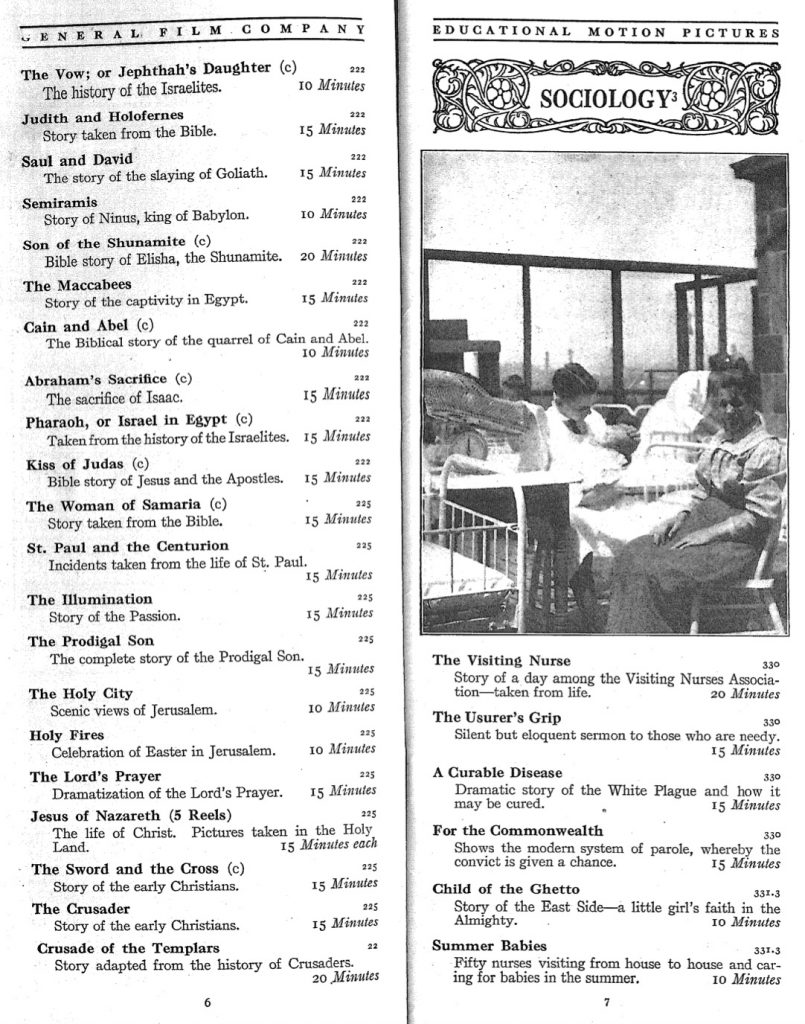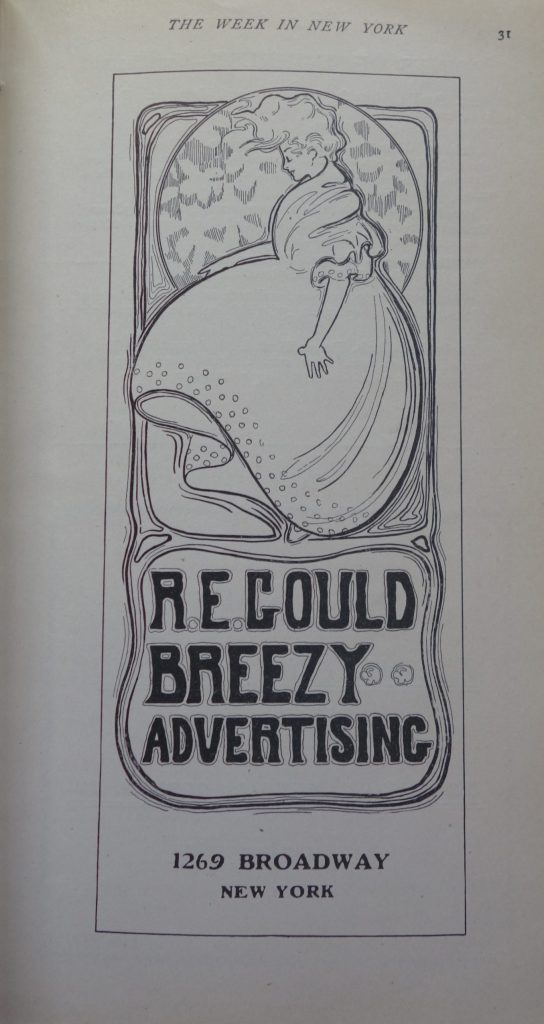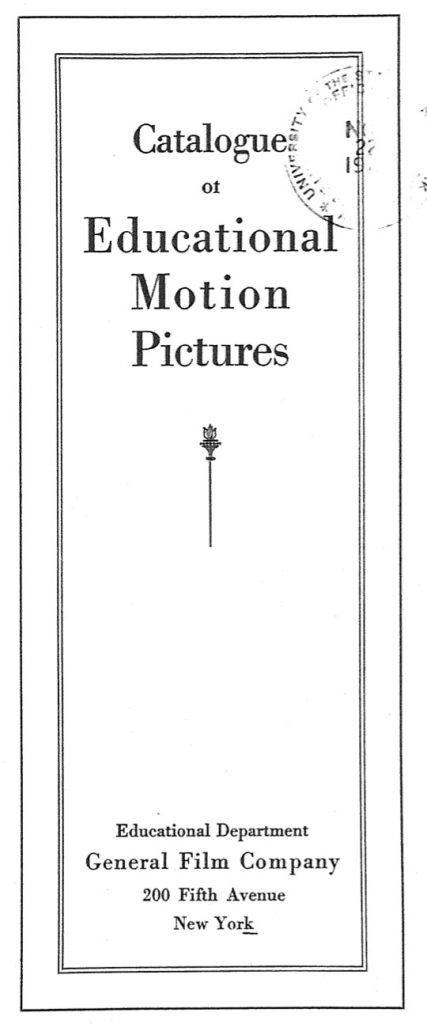One of the sharpest critiques of the cinema in the late aughts and early 1910s came from Progressive reformers, who sought to regulate both the spaces where movies were seen, particularly the “nickel” shows in poor, urban areas, and the stories and images presented in the cinema. But in addition to pushing for commercial regulation of the picture show, reformers also dreamed of an “educational cinema,” which would take the most edifying films screened in theaters and bring them to other sites, including schools. Ruth Gould Dolesé, trained as an arts educator, and one of the early members of the New York Board of Censorship of Motion Pictures (later the National Board of Censorship of Motion Pictures and then the National Board of Review of Motion Pictures), was one of the key players in the creation of an educational motion picture sector in the United States. In particular, her establishment of the Educational Department at the General Film Company in 1911, and, that same year, her publication of the Catalogue of Educational Motion Pictures made her a widely celebrated figure in the educational film movement, even though her early death in 1913 cut short a promising second career.
Ruth Ellen Gould was born in Delhi, New York, in 1868. The granddaughter and great-granddaughter of two United States congressmen (Herman D. Gould and Samuel Sherwood, respectively), Gould was a member of a prominent family in Delhi, a town of 3,000 people in upstate New York, ninety miles southeast of Albany. Her father, a railroad station agent, died in 1892. A few years later, Gould went to Chicago to study at the Art Institute of Chicago, where she began her career as an arts educator.
By 1898, Gould was working for the largest publisher of arts curricula in the United States, the Louis Prang Company. Although Prang got his start as a producer of commercial art, including some of the first Christmas cards, in the 1880s he began to move into the field of education. In Massachusetts, where Prang’s company was based, educational reformers had successfully pushed a new approach to art instruction in primary and secondary schools, including an 1870 state law that required school systems to teach drawing. In 1882, seeking to capitalize on the growing trend of arts instruction, Prang hired Mary Dana Hicks, author of successful curricula, and began pushing her manual under the Prang brand (Stankiewicz 145).
For five years, between 1898 and 1903, Gould was an energetic promoter of the Prang curricula, giving talks at teacher’s institutes, conferences, and club events across the country, including in cities and towns in Iowa, Montana, California, and, most frequently, Pennsylvania. While it is not clear whether Gould was paid for these speeches, it appears that her primary objective was to convince school boards to adopt Prang materials and to hire her as their district’s “supervisor of drawing” (“Artist To Be Wedded”), a role she could take on as an occasional consultant rather than as a permanent, full-time position. During this period, she also studied with Denman Ross, the most prominent design theorist of the early twentieth century, at Harvard, taking a summer course with him that he created specifically for arts educators (Frank 218).
By 1904, Gould appears to have quit working for Prang in order to explore other opportunities. Now living in New York, she established several businesses, including, with her close friend and business associate Laura Skinner, a magazine titled The Week in New York that was published between 1904 and 1906, and the R.E. Gould Company, a printshop and advertising firm. Advertisements for the latter appeared in the pages of The Week in New York, which provided event listings for busy New Yorkers. While neither of these businesses experienced long-term success, they established Gould as an important figure in the city’s art scene, which likely made her an attractive candidate for inclusion in other local organizations. In 1907, Gould married Henry Dolesé, vice president of a stone manufacturing company in Chicago. While a wedding announcement suggested that the new couple was planning to travel to Europe, and then move to Chicago, there is no evidence that either occurred (“Miss Ruth E. Gould Weds”). Instead, Dolesé—she now used her husband’s last name—remained in New York City, traveling alone to London in 1909, and staying active in the arts in New York while Henry lived in Chicago. In February 1910, Dolesé signed a new will, leaving her jewelry and businesses to her friend, Laura Skinner, and any remaining property to her sister, Katherine Gleason (“Ruth Gould Dolese” 83).
In early 1909, Dolesé became active in the nascent motion picture reform movement, which was centered in New York City. In what is now seen as a seminal event in American cinema history, in late December 1908, New York City’s mayor, George B. McClellan Jr., ordered the shuttering of all the city’s movie theaters, joining a swelling campaign by New York Progressives to regulate the production and exhibition of motion pictures. Four months later, in March 1909, the People’s Institute—one of the leading social work organizations in the city—established a new organization, the New York Board of Censorship of Motion Pictures, which would be the de facto censor for New York City and, because many film manufacturers were based in the city, the United States. From the start, the Board of Censorship relied on financing from the motion picture industry, particularly the newly established Motion Picture Patents Company (MPCC), an effort by Thomas Edison to use patent law to secure control of the motion picture industry. While this financing tied the Board of Censorship to the film companies, particularly those in the MPPC, its members were also interested in using their political power to force the industry to make films appropriate for children, and to encourage exhibitors to improve conditions in their storefront theaters.
In addition to setting up facilities to review motion pictures, the reformers behind the Board of Censorship were also interested in continuing work on another front, the establishment of an educational motion picture industry. In June 1909, board members voted for salaried positions for secretaries to direct its film censorship operations as well as its educational, national, and local and civic outreach work. In that same meeting, the board proposed sending a representative to London to acquire a “set of Urban educational pictures,” referring to the catalog created by the British traveling exhibitor and distributor Charles Urban in 1906 (Meeting Notes).
A month earlier, in May 1909, Dolesé was in attendance at a meeting of the Board of Censorship, evidence that supports her later claims that she was one of the founding members of the organization (“Mayor Finds No Law”). While it is unclear why Dolesé was selected to be on the board, her membership in the National Arts Club, which had been established almost a decade earlier, might have been a factor. Concerned that its reliance on film manufacturers for financing would damage its reputation, the Board of Censorship sought out members from a cross-section of New York society, provided, of course, that these individuals believed in its platform of voluntary censorship, not state action. While the educational activities of the Board of Censorship were less prominent than the “seal of approval” title cards that were soon inserted before the start of many films, board members appeared to be concerned with defining a role for the group that went beyond doing damage control for the industry.
Although it is not known when Dolesé was named to the Board’s Censoring Committee, newspapers articles from 1910 list her as a member, and her membership is noted in meeting notes and letterhead several times in 1911. That same year, Dolesé gave interviews and made public appearances on behalf of the Board of Censorship. For example, in March 1911, Dolesé argued in a newspaper interview published in the New York Evening Telegram that motion pictures held “moral and intellectual value” for education as well as the home life of children (Bean).
Later in 1911, Dolesé joined the General Film Company, the distribution arm of the MPCC, working as the head of the newly established Educational Department. While the Edison Film Company had long been interested in selling projectors and films to nontheatrical audiences, a broad category that included, per a 1906 ad, “fairs, schools, Y.M.C.A.’s, churches, [and] lodges,” it did not invest in making educational films until the early 1910s (Advertisement [Red Book Magazine]). At the same time, once Edison turned to educational cinema, it did so with fervor, claiming in a nationally circulated advertising campaign that the company was investing $3 million ($78 million adjusted for inflation) into the field (Advertisement [Seattle Star]). In September 1911, Dolesé published an editorial in the exhibitor trade publication Moving Picture World, which had started a column on educational film earlier that year. In her piece, Dolesé discussed the Educational Department and argued for the experiential value of motion pictures in the classroom:
Do you recall, as a child, the doubts that were foremost in your mind when you were told about some great natural phenomenon you had never seen? What does a mountain mean to a child who has never traveled beyond the boundary of the plains? What does the ocean mean to a child who dwells in the interior? A name only. And so we use pictures, photographs, drawings and paintings and they are helpful. But think what it means to see a motion picture! (Dolesé, “The Moving Picture as an Educator”)
One of Dolesé’s first, and most consequential, achievements in her new position was her creation of a film catalog, titled Catalogue of Educational Motion Pictures, which was published at the end of 1911.
In effect, this catalog can be seen as an effort to reposition the MPPC’s films as educational, thus creating a market that Edison would go on to dominate. Dolesé claimed that she viewed 300,000 films in order to select the 684 titles that ultimately appeared in the catalog, an unlikely feat, but evidence of the task at hand (“Death of Mrs. Dolese”). While the subjects of the films listed in the Catalogue of Educational Motion Pictures are similar to those in Charles Urban’s catalog, published five years earlier, Dolesé put considerable effort into making the catalog orderly, and designed it to be adapted to school curricula. The films are classified according to the Dewey Decimal System, featuring selections in seven of the ten classes outlined by Dewey: religion, sociology, natural science, useful arts, fine arts, literature, and history. Instead of giving the number of reels or feet of film, the catalog simply lists how many minutes it takes to view the film, which assumes that the operator is showing it at a standardized speed. All the films have short, descriptive titles, and are summarized in one sentence, giving it a certain economic poetry, as evinced by the following descriptions:
From the Field to the Cradle
Milk industry traced from farmer’s field and barn to the ultimate consumer—our baby (20);Otter Hunt
Story of the pursuit and final capture of creatures whose fur we covet (29);North Sea
In tempestuous mood, showing a wild sea with great foam covered waves. (15)

Sample pages from the religion and sociology film programs in the Catalogue of Educational Motion Pictures.
The catalog’s most novel feature are its film programs, designed either for an evening’s entertainment for particular audiences, such as churches and schools, or for integration in school curricula. In these film programs, Dolesé reconceived the use of motion pictures by focusing on their quality as representations of “objects” to be studied beyond entertainment. For example, she listed films to supplement a forty-week course titled “‘A Progressive Road to Reading’ by Motion Pictures,” modeled after a popular curriculum, offering titles within general subjects such as “Toys,” “Animals,” “Birds,” and “Flowers” (62). Dolesé also created film programs for the audiences who might be interested in educational films, including programs on religion, sociology, and one that was just for “general entertainment” (63).
Most importantly, however, Dolesé’s catalog was backed by the General Film Company, which committed to keeping the films she selected in circulation. In a 1912 letter, she assured one concerned exhibitor that “the subjects in our library are sometimes a year or two old, but we have only new prints” (Dolesé [Letter to J. Pelzer]). As a result, Dolesé managed to take an industry that was based on novelty—new titles, constantly—and ensure that one small piece of it would instead be based on permanence.
Dolesé died in September 1913, and the Educational Department of the General Film Company closed soon after. The films she collected were eventually sold to the Beseler Film Company, and, through the 1920s, it was considered to be one of the largest collections of educational films. In Arthur Edwin Krows’s serialized history of educational film, published in Educational Screen in the late 1930s and early 1940s, he credits Dolesé with the “reclamation idea,” the notion that a business could be founded on the “salvage of theatrical films for non-theatrical exhibition” (154). Although short-lived, Dolesé’s work as an editor and catalog writer casts a considerable shadow, as many educators, film distributors, and exhibitors continued to speak fondly of her, and the catalog that became her legacy.
See also: Anita Maris Boggs


